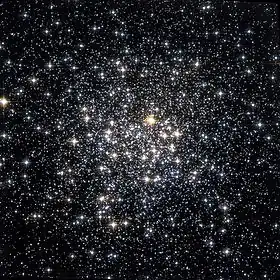< Messier Index
| Messier 107 | |
|---|---|
 M107 from w:Hubble Space Telescope; 3.5′ view Credit: w:NASA/w:STScI/w:WikiSky | |
| Observation data (w:J2000 epoch) | |
| Class | X |
| Right ascension | 16h 32m 31.91s[1] |
| Declination | -13° 03′ 13.1″[1] |
| Distance | 20.9 kly (6.4 kpc) |
| Apparent magnitude (V) | +8.85[1] |
| Apparent dimensions (V) | 13′.0 |
| Physical characteristics | |
| Mass | kg ( M) |
| Radius | 39.5 [2] |
| Other designations | NGC 6171, GCl 44[1] |
Globular Cluster M107 (also known as w:Messier Object 107 or NGC 6171) is a very loose w:globular cluster in the w:constellation w:Ophiuchus. It was discovered by w:Pierre Méchain in April w:1782 and independently by w:William Herschel in w:1793. It wasn't until w:1947 that w:Helen Sawyer Hogg added it and three other objects discovered by Méchain to the list of Messier objects.
M107 is close to the w:galactic plane at a distance of about 20,900 w:light-years from w:Earth. There are 25 known w:variable stars in this cluster.
External links
References
- 1 2 3 4 "SIMBAD Astronomical Database". Results for NGC 6171. http://simbad.u-strasbg.fr/Simbad. Retrieved 2006-11-16.
- ↑ distance × sin( diameter_angle / 2 ) = 39.5 ly. radius
| |||||
This article is issued from Wikibooks. The text is licensed under Creative Commons - Attribution - Sharealike. Additional terms may apply for the media files.